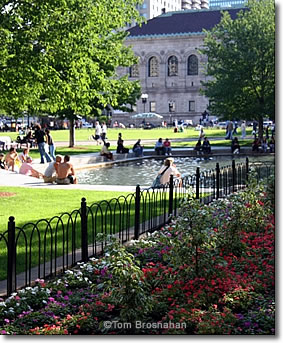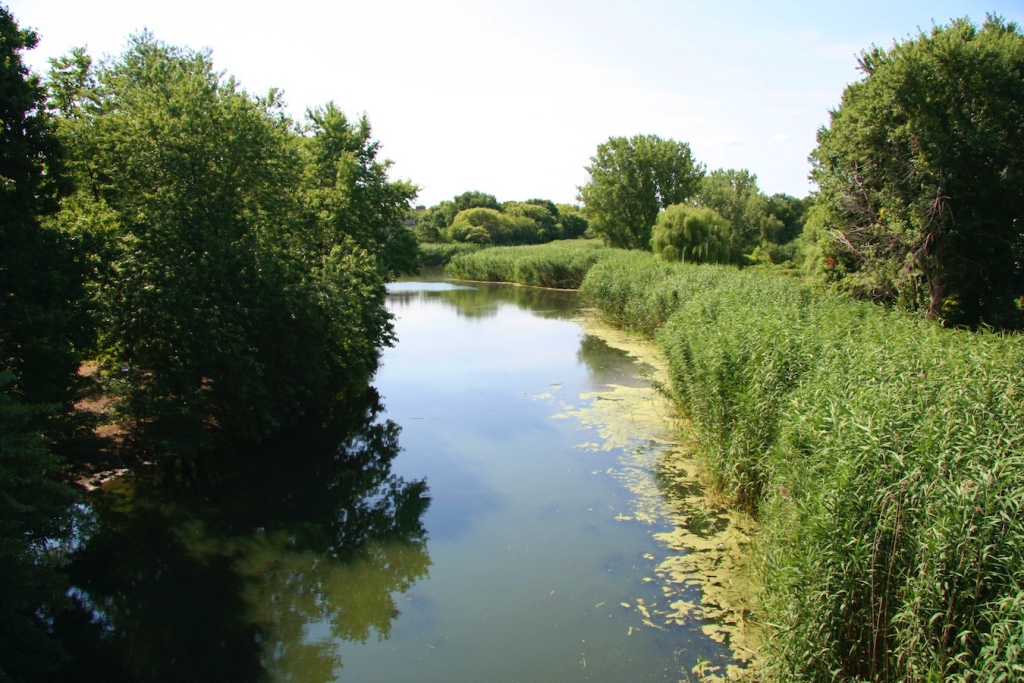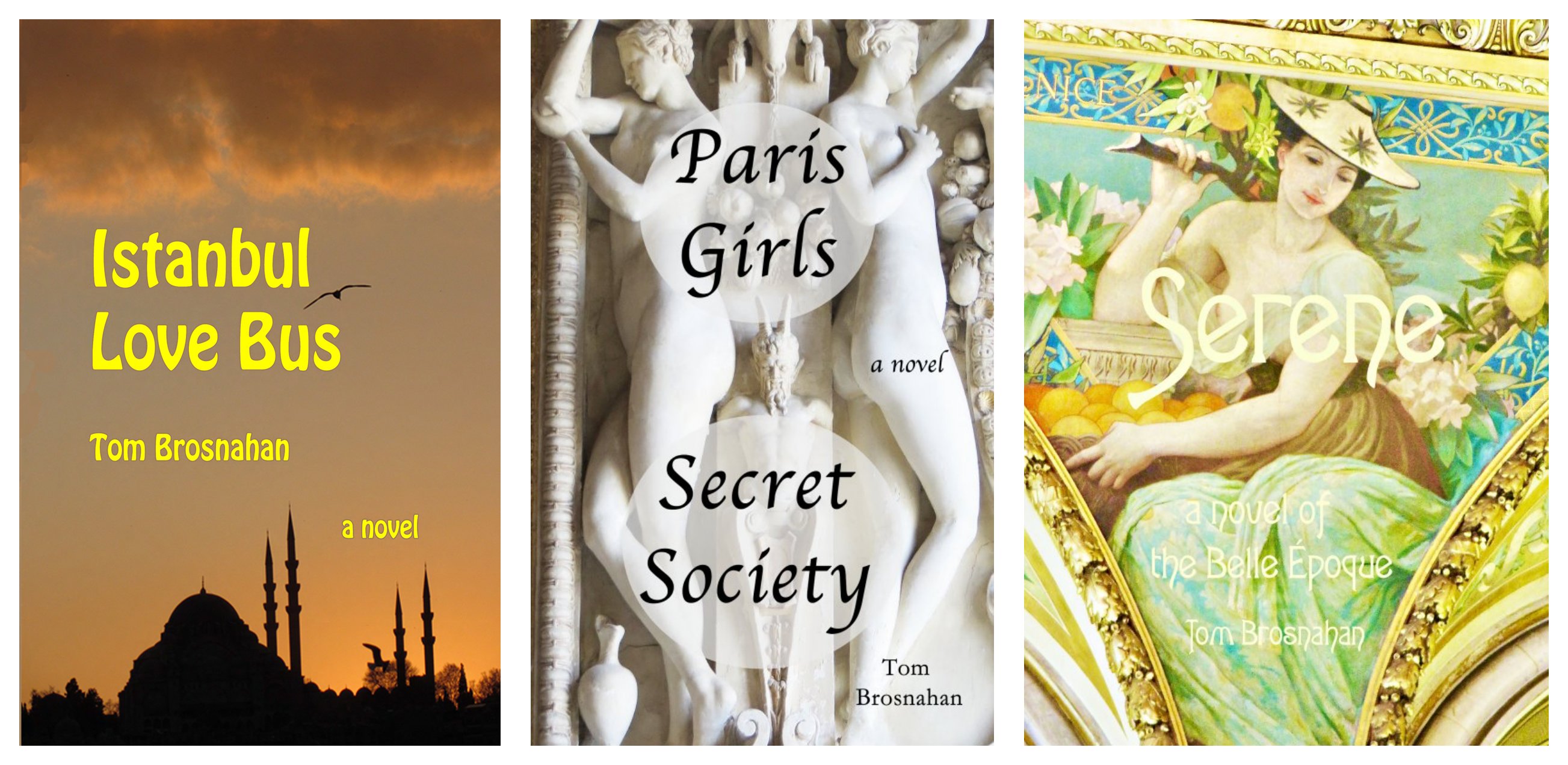Boston Parks
Subtitle

Boston Common
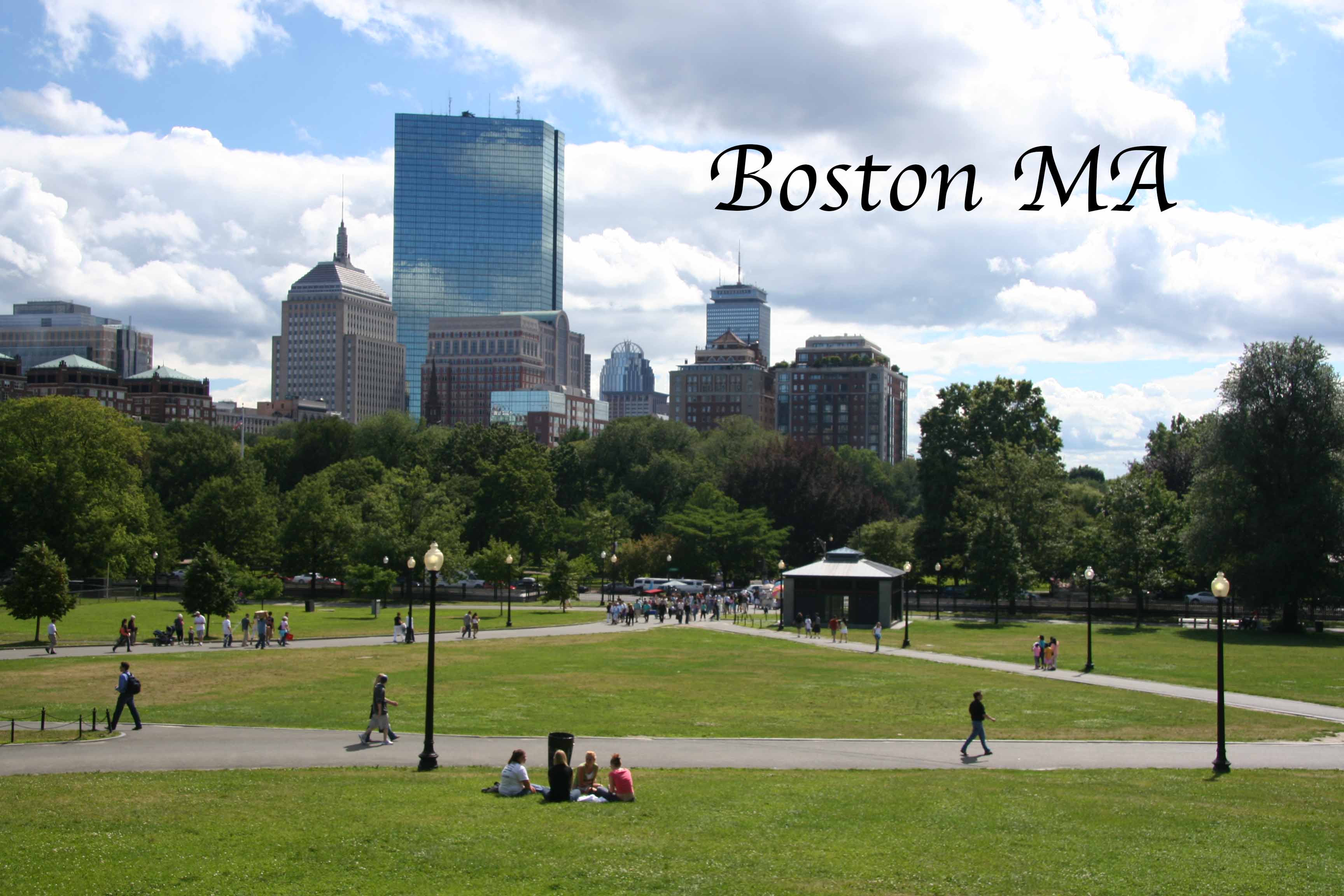
Many colonial towns preserved a central public square for markets, meetings and militia drills, but Boston, founded in 1630 and soon the largest settlement in New England, had none.
Pasturing cows was more important to these early settlers. The ordinance allowing any Bostonian to pasture a cow on the Common is apparently still in the lawbooks, though a stroll through the Common on any summer day reveals picnickers, sunbathers, soapbox orators, street buskers, pitch persons and plenty of pigeons, but no cows.
The entrance to the MBTA subway's Park Street Station at the corner of Tremont and Park streets is Boston's unofficial "speaker's corner," where ideologues hold for on their political, social and religious beliefs—those, at least, who have not become bloggers instead.
The Massachusetts State House (capitol) tops Beacon Hill at the Common's northeastern corner, and the Public Garden adjoins on the west side.
During its explosive growth in the 19th century, Boston's government was smart enough to hire famed landscape architect Frederick Law Olmsted, creator of New York City's beautiful Central Park, to make a master plan for Boston's green spaces.
Olmsted's masterpiece was the Emerald Necklace, a chain of green spaces, old and new, from Boston Common and the newer Public Garden at the heart of the city, along Commonwealth Avenue in the Back Bay to the Back Bay Fens, and finally to the Arnold Arboretum, miles from the center.
Olmsted beautified the Common, preserving a colonial and early American cemetery near the corner of Tremont and Boylston streets, but adding statues, monuments and a Frog Pond that serves as a wading pool and fountain for children in summer, and an ice skating rink in winter.
Public Garden
In colonial times the land west of Boston Common was salt marsh, but when the Back Bay was filled in during the 19th century, architect George Meacham was hired (1860) to turn this 24-acre (10-hectare) plot into a formal French-style public garden.
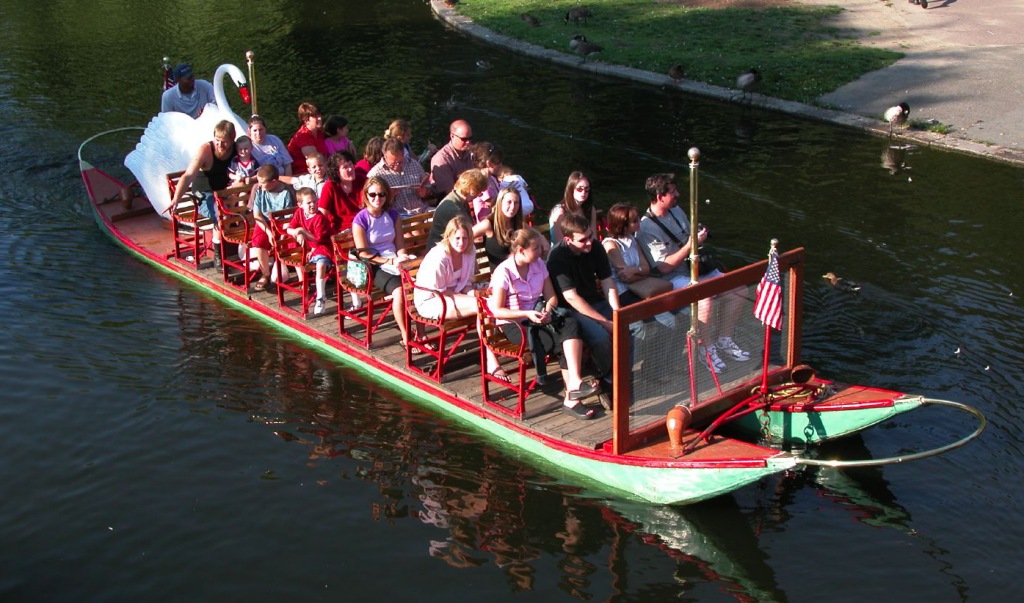
Swan boat cruise on the lagoon in the Public Garden.
Meandering through its center is a 4-acre (1.6-hectare) lagoon crossed by a small suspension bridge (1867). Pedal-powered swan boats have been giving locals and visitors, children and adults, slow, serene figure-eight cruises around the lagoon and its small island since 1877.
At the ends of the suspension bridge are formal flower beds that blaze with tulips in spring, and are bright with color well into autumn.
Though you can sit or stretch out on the grass of Boston Common as you like, regulations prohibit walking or sitting on the lawns of the Public Garden. Use the benches and walks instead.
On the west side of the Public Garden, facing the Arlington Street gate, is an equestrian statue of George Washington (1869) by Thomas Ball. The great general and America's first president is drawing his sword as if to order an attack the British occupiers of Boston. (Washington's fortification of Dorchester Heights in March 1776 did in fact persuade British General Howe to evacuate Boston, so no attack was necessary.)
North of the Washington statue, the Ether Monument (1866) commemorates the first successful demonstration of general anesthesia (1846) at Massachusetts General Hospital. This milestone in medical science was hailed as the "greatest gift ever made to suffering humanity," putting an end to centuries of pain suffered during medical surgery.
The statue at the southwestern corner of the Public Garden (corner of Arlington and Boylston streets) is of Transcendentalist William Ellery Channing (1780-1842), anti-slavery speaker and Unitarian minister of the Arlington Street Church across the street.
On the east side of the garden by the Charles Street gate, is a statue of Boston writer and philanthropist Edward Everett Hale, author of The Man Without a Country.
On the north side of the suspension bridge, near the east side of the lagoon, a row of ducks sculpted in bronze celebrates Make Way for Ducklings, the children's classic story (1941) by Robert McCloskey of a family of ducks who journey from the Public Garden to the Charles River Esplanade and the city that stops to let them pass.
On the western side of the Public Garden, park-like Commonwealth Avenue carries Frederick Law Olmsted's inspired concept of an Emerald Necklace of green space westward.
The Emerald Necklace
Around 1878, the great landscape architect Frederick Law Olmsted, designer of New York City's Central Park, was consulted regarding a plan for Boston's public parks.
His brilliant concept was to unite Boston's existing historic public parks and green spaces, such as Boston Common and the Public Garden, with other natural and preserved spaces in Boston and Brookline into a chain of greenery encompassing 1100 acres (445 hectares).
Starting at historic Boston Common, the Emerald Necklace extends for seven miles (11 km) through the city along Commonwealth Avenue in the Back Bay, along the Back Bay Fens, Jamaica Pond and the Jamaicaway to the Arnold Arboretum and Franklin Park well to the south.
You will certainly spend at least a little time in Boston Common and the Public Garden, but if time allows you should also walk from the Public Garden along the shady mall of Commonwealth Avenue.
If you visit Boston's Museum of Fine Arts, you will observe the Back Bay Fens, turned from a swamp into a lovely park.
Arnold Arboretum, almost six miles (10 km) southwest of Boston Common, would take a special trip, but you'd be repaid by a visit to a splendid botanical garden filled with native and exotic plants, flowers and trees.
The Emerald Necklace is one example of the priceless legacies bequeathed to later generations by the brilliant thinkers, planners and civic-minded giants of the 19th century who built the United States.
The Emerald Necklace Conservancy works to preserve Olmsted's parks and gardens, organizes events , and publishes information to enrich everyone's enjoyment of this natural treasure. More...
Commonwealth Avenue Mall
Boston is a city of districts and neighborhoods, with few grand boulevards. The exception is the Back Bay district, which was a planned 19th-century development built on filled land.
Commonwealth Avenue Mall, a wide, tree-lined path between two roadways, is the main thoroughfare of Back Bay, an important link in Frederick Law Olmsted's Emerald Necklace of green spaces extending from Boston Common for miles to the Arnold Arboretum.
Starting at the Public Garden, "Comm Ave" (as it's commonly called) extends southwestward for more than a mile, lined with grand townhouse mansions and studded with statues and benches. It ends at the Back Bay Fens, which extend the Emerald Necklace southward and westward toward Jamaica Plain.
The shorter north-south streets of Back Bay that cross Commonwealth Avenue have been named in alphabetical order. Thus if you go westward along Commonwealth Avenue from the Public Garden you'll cross Arlington, Berkeley, Clarendon, Dartmouth, Exeter, Fairfield, Gloucester and Hereford before the system dies and you come to Massachusetts Avenue.
West of "Mass Ave" the greenery of Commonwealth Avenue continues for several more blocks through Charlesgate, which joins the Back Bay Fens.
Copley Square
Walking west from Boston Common for 10 or 15 minutes on Boylston Street in Back Bay brings you to Copley Square (map), at the corner of Boylston St and Dartmouth St, bounded by those streets and St James Avenue. The square is framed by the classic Boston Public Library, the elegant Fairmont Copley Plaza Hotel, and Henry Hobson Richardson's famous Trinity Church, built in the late 1800s.
Part of the square is a pretty, green, partly shady park with a pool, flowerbeds and benches. Modern intruders on this gentility are the striking mirror-glass shaft of the John Hancock Tower and, a block west, the sprawling office-and-shopping complex called Copley Place.
On the west side of the Boston Public Library is the John B Hynes Veteran's Memorial Convention Center, the smaller of Boston's two official convention centers (the larger one being the Boston Convention & Exhibition Center in the Seaport District of South Boston. )
North of Copley Square along Clarendon and Dartmouth streets is Newbury Street, with its boutiques and sidewalk restaurants, and beyond that Commonwealth Avenue.
All trains on the MBTA subway's Green Line, eastbound and westbound, stop at the Copley Square station. After Copley, westbound B, C, D and E trains follow different routes to their destinations.
Back Bay Fens
The Back Bay Fens' unappetizing name designates a pretty park that is an important link in Olmsted's Emerald Necklace (map). The Fens are the southward and westward continuation of the Emerald Necklace, joining the western end of Commonwealth Avenue.
Even though the Fens are bounded by busy streets—The Fenway and Park Drive—the Fens provide welcome greenery views to the people living in the stately stone and brick residential buildings that frame the parkland.
Just west of the northern end of the Back Bay Fens is famous Fenway Park, home of the Boston Red Sox baseball team. On the opposite (east) side of the northern end of the Fens is the Boston Conservatory of Music. At the southern extent of the Fens are Boston's renowned Museum of Fine Arts, the Isabella Stewart Gardner Museum, Simmons University, Emmanuel College and Boston University's Wheelock College.
Arnold Arboretum
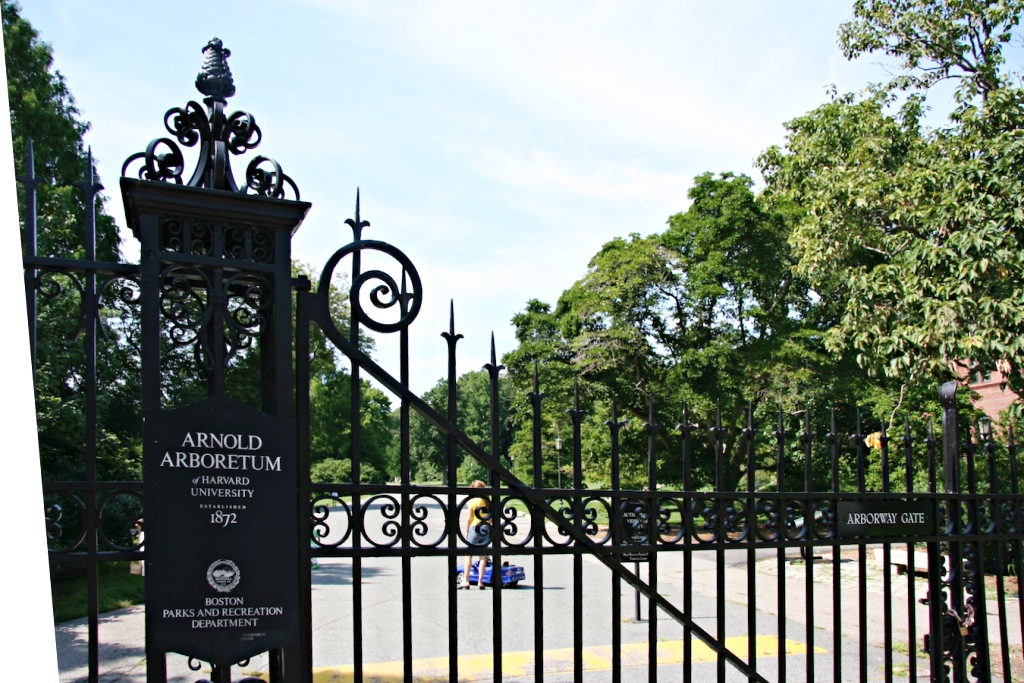
Arnold Arboretum of Harvard University
Ever since this 265-acre (107-hectare) park at 125 Arborway (map) was given to the city by Harvard University, Bostonians have been coming here to the Jamaica Plain district (map) to enjoy the peacefulness of the park and its vast collection of trees and plants. Designed by Charles Sprague Sargent and Frederick Law Olmsted, the Arboretum is a significant link in Olmsted's Emerald Necklace.
Spring is the best time to catch the first blossoms like the lilacs at the Arboretum, but in fact anytime is a good time. There's lots to see. Early summer brings the rhododendrons, and all through the warm months the scents here will bring back any nose dulled by the city air.
The Arnold Arboretum is open daily from dawn to dusk. Take an Orange Line subway train to Forest Hills, or a Green Line train to Arborway (the Orange Line's probably faster). If you drive, you can often find parking near the Arboretum's gates, but observe the signs that caution you to lock your car and to leave no valuables in it—particularly not within sight.
If you travel to the Arboretum, you may also want to visit nearby Franklin Park and its Franklin Park Zoo. The western edge of Franklin Park almost touches the Arboretum (this is an Emerald Necklace, after all), but the Zoo is about two miles (3 km) east of the Arboretum's main gate.
